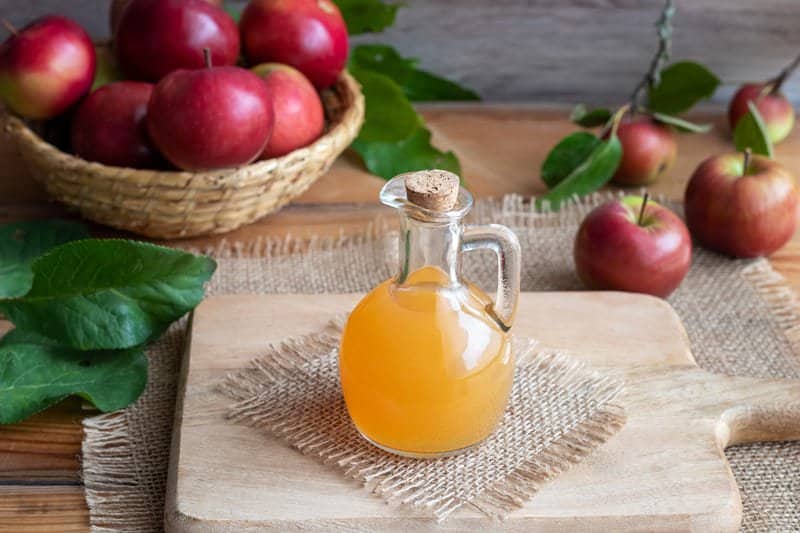Fall is just around the corner and nothing reminds us of this season like fresh apple cider.
Apple cider is not only used for drinking but can also be used in cooking food from doughnuts to dumplings.
From a beverage to vinegar, apple cider can be used in many ways. It’s also very healthy and nutritious. The main difference between apple cider and apple cider vinegar is that the vinegar has been fermented into alcohol and then converted into acetic acid, whereas the cider is more like apple juice.
But what if you don’t have any apple cider at home and the recipe requires it? Is there anything else that can be used instead?
Can I substitute apple cider? Yes you can. This article will provide the best apple cider substitutes including apple juice, lemon juice, rice wine vinegar, red wine vinegar, white wine vinegar, white wine and sherry vinegar.
Also, read more about the difference between apple cider juice and apple cider vinegar and some good recipes for making the best home-made apple cider that can then be turned into vinegar. And last but not least, we will tell you how to save your ribs with the provided substitutes.
Also Check: Apple Cider Vinegar Substitutes
Substitutes for Apple Cider
Since apple cider is used in recipes as well as vinegar, here is a list of substitutes that can help you save your meal. These are the substitutes that have almost the same taste as the cider and will fit most recipes. Use the same amount of these substitutes in your recipe:
1. Apple juice
The closest substitute for apple cider is apple juice. If you are using the juice as a substitute in your recipe, make sure it is the unsweetened version so that your recipe won’t be far from its original flavor.
2. Lemon juice
Lemon juice is also very high in acid with a low pH, so the fruity tones and the acidy taste will help you save your meal. Use lemon juice to prove a similar flavor and taste to apple cider.
3. Rice wine vinegar
Lacking the slight sweetness and with a fruity flavor, rice wine vinegar will help you to bring out the acidy taste. It’s an excellent match in your recipe. It does not have the same health benefits as the apple cider, but it’s a good way to bring out flavors in salad dressings. Also, you can add a teaspoon of lemon juice to make it more fruity.
4. Red wine vinegar

5. White wine vinegar
Another type of wine vinegar that will easily help you substitute apple cider in your recipe. Again, use just a little to start with – you can always add more if it’s not acidic enough for you. The flavor is sharp and lacks the fruitiness of apple cider but it still works and fits well.
6. White wine
Use two tablespoons of white wine for one tablespoon of apple cider to match the taste in your recipe. A bottle of white wine will save your meal if you don’t have apple cider. The sweetness of apple cider is very similar to that of white wine.
7. Sherry vinegar

Apple Cider Substitute for Ribs
If you are halfway through your recipe for making ribs and you realise that you have no apple cider, don’t worry I will help you save your dish! All you do is use apple juice instead. This will add the same apple flavor to the rib sauce as the cider.
Also, by adding apple juice, you will help to create steam inside the foil, so your ribs won’t be dry, but instead will be juicy and tasty. You can also use orange or pineapple juice as well – this makes very delicious ribs!
Apple Cider: Juice vs. Vinegar
Apple cider is a delicious drink, and apple cider vinegar is said to be the cure for many things. Both types of apple cider are nutritious, and they are basically the same. Both made from apples, they are remarkably similar and yet also have a few differences.
The juice is from freshly pressed whole, crushed apples. This is also called sweet cider or non-alcoholic cider. The juice is filtered and then pasteurized for safe consumption.
Whereas the vinegar is fermented and is made from a combination of water and acetic acid. It’s made by fermenting apples into natural sugar alcohol and then adding bacteria to prevent the alcohol from turning into acetic acid.
Don’t worry if there is no apple cider in the store, read below to find out how to make apple cider at home. Another important thing to note is the process of turning apple cider into vinegar.
Homemade Apple Cider:
There is always the option of making this product at home. Apple cider is very easy and fast to make. See below for the ingredients and the process of making it.
This homemade apple cider is a good way to make all of your recipes even tastier, as it gives more texture to the whole meal. Once it’s made, the apple cider can stay in the fridge for 2 weeks – just make sure that you let it cool completely before storing it in your fridge.
All you need is:
- 10 large apples,
- ½ orange
- 4 cinnamon sticks
- 1 tablespoon allspice
- 1 tablespoon of cloves
- 1 pack of brown sugar
- 1 whole nutmeg
Steps
- Put a large pot on a medium heat.
- Add the apples, then the orange, the spices and then the brown sugar.
- Let it boil and then reduce the heat and simmer for 2 hours.
- Remove the orange and use a masher to mash the apples.
- Let them simmer uncovered for another hour.
- Squeeze the juices out and discard the solids.
- Your apple cider is ready to serve and use in recipes.
The process of turning the apple cider into vinegar:
There is also the option to turn the cider juice into vinegar. Simply leave an open container of apple cider so it can ferment naturally. It usually takes 2-4 weeks to turn it into vinegar.
The fermentation process needs the cider to be exposed to as much air as possible. Protect it from insects by covering it with cheesecloth. This will allow the cider to breathe.
You’ll know when it’s done by the taste of it. That’s the prime determiner. First, the taste is carbonated, then the sweetness and bubbling flatten and it takes on an alcoholic taste with a very dry texture. Once the acids develop, the sourness will take over and your apple cider is now vinegar.
Related questions
What is the difference between apple juice and apple cider?
Since they are both made from apples, you probably think that there wouldn’t be any differences but there is something that distinguishes one from the other. Apple cider is made from apples that are washed, cut and ground, whereas the apple juice goes under fermentation to remove pulp and is then pasteurized to extend the life of the juice.
What can I use instead of apple cider vinegar for baking?
Well, you can substitute 1 tablespoon of lemon juice, or you can use lime juice, or you can also add 2 tablespoons of white wine. These substitutes don’t have the same nutritional value as the apple cider and do not have the same health benefits, but you’ll get the flavor that you’ll need.





1 comment
Thank you Saurabh for writing this. I cannot drink cider but would love to make some of the wonderful dishes others eat and leave me drooling. I will be using pineapple and apple juice in addition to lemon use, of which I get through lots! I’m hoping to jazz up our Christmas now!